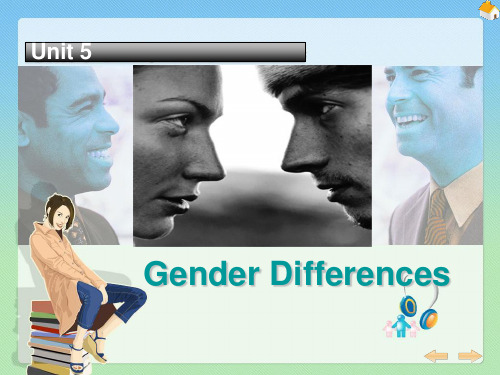Gender Difference
- 格式:ppt
- 大小:4.58 MB
- 文档页数:14


PREPARATION (20 minutes)READING-CENTERED ACTIVITIES1.T ext organization (5 minutes)1) Introduction (Para.1)It has been proven repeatedly that the various types of behavior, emotions, and interests that constitute being masculine and feminine are patterned by both heredity and culture2) There is a cultural bias in education that favors boys over girls. (Para.2—4)Supporting evidence:A. T eachers called on males in class far more than on female students. (Para.2)a. Its consequence: This has a tremendous impact on the learning process。
b. The reason for this: Active classroom participants develop more positive attitudes and go on to higher achievement.c. Two examples:i. In many of former all-women‟s colleges, the boys were “taking over”the classroom discussions and active participation by women students had diminished noticeably.ii. A similar subordination of female to male students has also been observed in law and medical school classrooms in recent years.B. T eachers assigned boys and girls different tasks in accordance with stereotypedgender roles. (Para.3)a. Its consequence: This prevented girls from participating as actively as boys in classb. An example: A teacher had the little boys perform the scientific “experiment” while the girls were given the task of putting the materials awayC. Gender-biased education is also reflected in the typical American teacher’sassumption. (Para.4)a. The assumption: Boys will do better in the “hard”, “masculine” subjects of math and science while girls are expected to have better verbal and reading skills。

Unit 3 Gender DifferenceGender Roles from a Cultural PerspectiveOver the past few decades, it has been proven innumerable times that the various types of behavior, emotions, and interests that constitute being masculine and feminine are patterned by both heredity and culture. In the process of growing up, each child learns hundreds of culturally patterned details of behavior that become incorporated into its gender identity. Some of this learning takes place directly. In other words, the child is told by others how to act in an appropriately feminine or masculine way. Other details of gender behavior are taught unconsciously, or indirectly, as the culture provides different images, aspirations, and adult models for girls and boys.Recently, for example, a study of American public schools showed that there is a cultural bias in education that favors boys over girls. According to the researchers, the bias is unintentional and unconscious, but it is there and it is influencing the lives of millions of schoolchildren every year. Doctors David and Myra Sadker videotaped classroom teachers in order to study gender-related bias in education. Their research showed that many teachers who thought they were nonsexist were amazed to see how biased they appeared on videotape. From nursery school to postgraduate courses, teachers were shown to call on males in class far more than on female students. This has a tremendous impact on the learning process for, in general, those students who become active classroom participants develop more positive attitudes and go on to higher achievement. As a matter of fact, in the late 1960s, when many of the best all-women's colleges in the northeastern United States opened their doors to male students, it was observed by professors and women students alike that the boys were "taking over" the classroom discussions and that active participation by women students had diminished noticeably. A similar subordination of female to male students has also been observed in law and medical school classrooms in recent years.3 Research done by the Sadkers showed that sometimes teachers unknowingly prevented girls from participating as actively as boys in class by assigning them different tasks in accordance with stereotyped gender roles. For instance, one teacher conducting a science class with nursery school youngsters, continually had the little boys perform the scientific "experiment" while the girls were given the task of putting the materials away. Since hands-on work with classroom materials is a very important aspect of early education, the girls were thus being deprived of a vital learning experience that would affect their entire lives.Another dimension of gender-biased education is the typical American teacher's assumption that boys will do better in the "hard", "masculine" subjects of math and science while girls are expected to have better verbal and reading skills. As an example of a self-fulfilling prophecy, American boys do, indeed, develop reading problems, while girls, who are superior to boys in math up to the age of nine, fall behind from then on. But these are cultural, not genetic patterns. In Germany, for example, all studies are considered "masculine", and it is girls who develop reading problems. And in Japan, where early education appears to be nonsexist, both girls and boys do equally well in reading.The different attitudes associated with the educational process for girls and boys begin at home. One study, for example, showed that when preschoolers were asked to look at a picture of a house and tell how far away from the house they were permitted to go, the boys indicated a much wider area than the girls, who generally pointed out a very limited area close to the home. Instead of being encouraged to develop intellectual curiosity and physical skills that are useful in dealing with the outside world, as boys are, girls are filled with fears of the world outside the home and with the desire to be approved of for their "goodness" and obedience to rules. These lessons carry over from the home to the classroom, where girls are generally observed to be more dependent on the teacher, more concerned with the form and neatness of their work than with its content, and more anxious about being "right" in their answers than in being intellectually independent, analytical, or original. Thus, through the educational process that occupies most of the child's waking hours, society reinforces its established values and turns out each gender in its traditional and expected mold.从文化角度看性别角色1 在过去的几十年里,已经无数次地证实了这样一个事实:构成男子阳刚之气和女子阴柔之气的各种不同类型的行为、情感、和兴趣都既是遗传又是文化熏陶的结果。


Unit 3 Gender DifferenceGender Roles from a Cultural PerspectiveOver the past few decades, it has been proven innumerable times that the various types of behavior, emotions, and interests that constitute being masculine and feminine are patterned by both heredity and culture. In the process of growing up, each child learns hundreds of culturally patterned details of behavior that become incorporated into its gender identity. Some of this learning takes place directly. In other words, the child is told by others how to act in an appropriately feminine or masculine way. Other details of gender behavior are taught unconsciously, or indirectly, as the culture provides different images, aspirations, and adult models for girls and boys.Recently, for example, a study of American public schools showed that there is a cultural bias in education that favors boys over girls. According to the researchers, the bias is unintentional and unconscious, but it is there and it is influencing the lives of millions of schoolchildren every year. Doctors David and Myra Sadker videotaped classroom teachers in order to study gender-related bias in education. Their research showed that many teachers who thought they were nonsexist were amazed to see how biased they appeared on videotape. From nursery school to postgraduate courses, teachers were shown to call on males in class far more than on female students. This has a tremendous impact on the learning process for, in general, those students who become active classroom participants develop more positive attitudes and go on to higher achievement. As a matter of fact, in the late 1960s, when many of the best all-women's colleges in the northeastern United States opened their doors to male students, it was observed by professors and women students alike that the boys were "taking over" the classroom discussions and that active participation by women students had diminished noticeably. A similar subordination of female to male students has also been observed in law and medical school classrooms in recent years.3 Research done by the Sadkers showed that sometimes teachers unknowingly prevented girls from participating as actively as boys in class by assigning them different tasks in accordance with stereotyped gender roles. For instance, one teacher conducting a science class with nursery school youngsters, continually had the little boys perform the scientific "experiment" while the girls were given the task of putting the materials away. Since hands-on work with classroom materials is a very important aspect of early education, the girls were thus being deprived of a vital learning experience that would affect their entire lives.Another dimension of gender-biased education is the typical American teacher's assumption that boys will do better in the "hard", "masculine" subjects of math and science while girls are expected to have better verbal and reading skills. As an example of a self-fulfilling prophecy, American boys do, indeed, develop reading problems, while girls, who are superior to boys in math up to the age of nine, fall behind from then on. But these are cultural, not genetic patterns. In Germany, for example, all studies are considered "masculine", and it is girls who develop reading problems. And in Japan, where early education appears to be nonsexist, both girls and boys do equally well in reading.The different attitudes associated with the educational process for girls and boys begin at home. One study, for example, showed that when preschoolers were asked to look at a picture of a house and tell how far away from the house they were permitted to go, the boys indicated a much wider area than the girls, who generally pointed out a very limited area close to the home. Instead of being encouraged to develop intellectual curiosity and physical skills that are useful in dealing with the outside world, as boys are, girls are filled with fears of the world outside the home and with the desire to be approved of for their "goodness" and obedience to rules. These lessons carry over from the home to the classroom, where girls are generally observed to be more dependent on the teacher, more concerned with the form and neatness of their work than with its content, and more anxious about being "right" in their answers than in being intellectually independent, analytical, or original. Thus, through the educational process that occupies most of the child's waking hours, society reinforces its established values and turns out each gender in its traditional and expected mold.从文化角度看性别角色1 在过去的几十年里,已经无数次地证实了这样一个事实:构成男子阳刚之气和女子阴柔之气的各种不同类型的行为、情感、和兴趣都既是遗传又是文化熏陶的结果。

性别差异英语作文Gender Differences。
Gender differences have been a topic of debate for many years. Men and women are different in many ways, including their physical, emotional, and mental characteristics. These differences can be attributed to biological, social, and cultural factors.One of the most obvious gender differences is physical strength. Men are generally stronger than women due totheir larger muscle mass and bone density. This difference can be seen in sports, where men dominate in events requiring physical strength and endurance. However, women have certain physical advantages, such as greaterflexibility and a lower center of gravity, which make them better suited for some sports.Emotional differences between men and women are also apparent. Women are often considered more emotional andempathetic than men. They tend to be more in touch with their feelings and express them more openly. Men, on the other hand, are often more reserved and less likely to share their emotions. This difference can be attributed to social and cultural factors, as men are often taught to be stoic and unemotional.Mental differences between men and women are lessclear-cut. Some studies suggest that men are better at spatial tasks, while women are better at verbal tasks. However, these differences are not absolute, and there is a great deal of overlap between the sexes. It is also important to note that these differences may be influenced by cultural and environmental factors, such as education and upbringing.Gender differences can have both positive and negative effects. On the one hand, they can lead to greaterdiversity and complementarity in relationships and workplaces. On the other hand, they can also lead to stereotypes and discrimination. It is important to recognize and appreciate the differences between men andwomen while also promoting equality and respect for all individuals.In conclusion, gender differences are a complex and multifaceted topic. While there are observable differences between men and women, it is important to recognize that these differences are not absolute and may be influenced by social, cultural, and environmental factors. By promoting equality and respect for all individuals, we can create a more inclusive and harmonious society.。
Gender Differences: A Cross-CulturalPerspectiveGender differences have always been a topic of interest, with various studies and perspectives aiming to understand the nuances and complexities involved. Cultural backgrounds play a crucial role in shaping gender roles and expectations. In Western cultures, for instance, the traditional gender roles often depict men as strong, assertive, and leaders, while women are seen as nurturing, caring, and submissive. However, in Eastern cultures, the gender roles are often more fluid and interdependent, with both men and women expected to exhibit qualities of leadership, assertiveness, and nurturing.The workplace is one arena where gender differences are particularly evident. In some industries, such as technology, men tend to dominate the higher echelons of leadership. However, this is not to say that women are absent or unable to excel in these fields. In fact, studies have shown that companies with gender-diverse leadership teams tend to perform better. This highlights theimportance of fostering an inclusive culture that values diversity and promotes equal opportunities for both genders. Education systems also play a crucial role in shaping gender roles. While girls are often encouraged to pursue fields like humanities and social sciences, boys aresteered towards STEM subjects. However, this trend isslowly changing as more girls are encouraged to pursue STEM fields, and boys are being given the freedom to exploreother areas of interest.In conclusion, gender differences are complex and multifaceted, shaped by a combination of cultural, social, and biological factors. It is important to recognize these differences and work towards creating an inclusive society that values and respects the contributions of both genders. Only then can we truly achieve gender equality and unlockthe full potential of our society.**性别差异:跨文化视角**性别差异一直是人们感兴趣的话题,各种研究和观点都旨在理解其中所涉及的细微差别和复杂性。
英语作文男女差异Gender Differences。
Gender differences have been a topic of interest and debate for many years. It is widely recognized that men and women have distinct characteristics and behaviors that are influenced by biological, psychological, and social factors. While some argue that these differences are innate, others believe that they are primarily shaped by societal expectations and norms. This essay will explore the various aspects of gender differences and their implications.One of the most prominent differences between men and women lies in their physical attributes. Men are generally taller and stronger than women due to biological factors such as hormones and genetics. This physical advantage has historically led to men dominating certain fields such as sports and manual labor. However, it is important to note that this does not imply that women are inferior or incapable. Women have their own unique strengths andabilities, such as better endurance and flexibility.Another significant difference between men and women is their cognitive abilities. Research has shown that men tend to excel in certain areas such as spatial reasoning and mathematical skills, while women often perform better in verbal and emotional intelligence tasks. These differences may be influenced by both biological and environmental factors. For example, hormonal differences during prenatal development may affect brain structure and function, leading to variations in cognitive abilities.In addition to physical and cognitive disparities, men and women also exhibit divergent behavioral patterns. Men are often more assertive, competitive, and risk-taking, whereas women tend to be more nurturing, empathetic, and cooperative. These differences can be attributed to both biological and social factors. Evolutionary psychologists argue that these behavioral traits have evolved to fulfill specific gender roles. For instance, men historically engaged in hunting and protecting their families, which required assertiveness and risk-taking. On the other hand,women took on caregiving roles, requiring empathy and cooperation.Furthermore, gender differences are also reflected in career choices and occupational preferences. It is widely observed that men dominate fields such as engineering, technology, and finance, while women are more likely to pursue careers in education, healthcare, and social work. These disparities can be attributed to a variety of factors, including societal expectations, cultural norms, and personal interests. Despite efforts to promote gender equality in the workplace, certain gender biases and stereotypes continue to influence career choices.While it is important to acknowledge and understand gender differences, it is equally crucial to avoid generalizations and stereotypes. Each individual is unique and should not be limited or judged based on their gender. Society should strive to provide equal opportunities and eliminate gender biases in order to foster a more inclusive and egalitarian environment.In conclusion, gender differences exist in various aspects of life, including physical attributes, cognitive abilities, behavioral patterns, and career choices. These differences are shaped by a combination of biological, psychological, and social factors. It is essential to recognize and appreciate these differences while promoting equality and challenging gender stereotypes. By doing so, we can create a more diverse and inclusive society where everyone has the opportunity to thrive.。